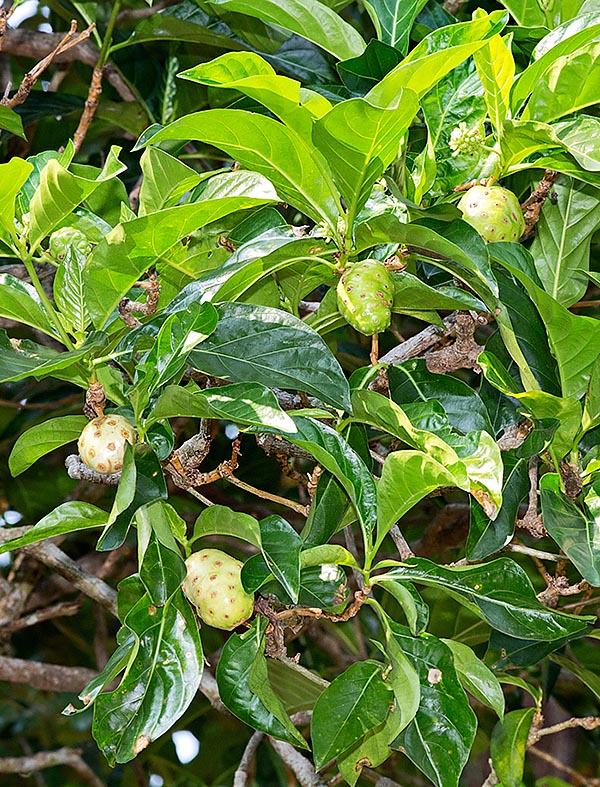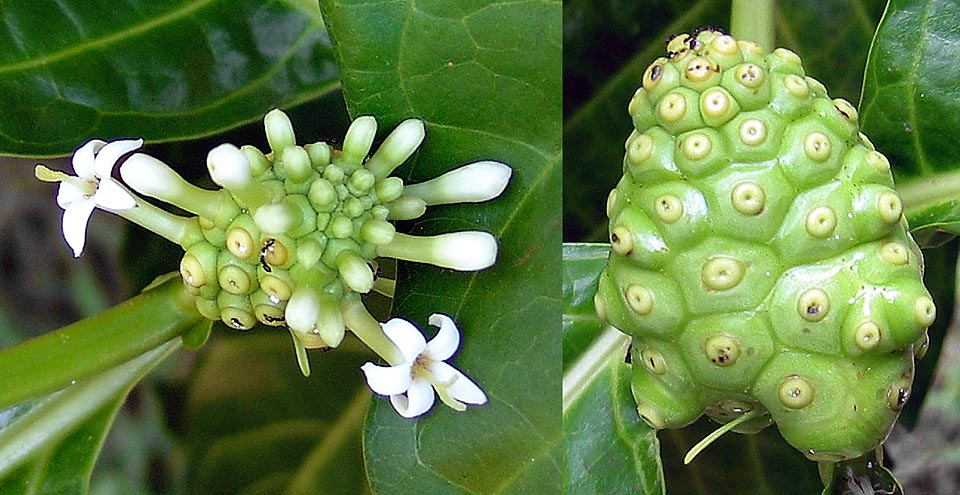Family : Rubiaceae

Text © Pietro Puccio

English translation by Mario Beltramini

Morinda citrifolia is a 3-8 m small tree. The odd quadrangular stem reaches 15 cm © Giuseppe Mazza
The name of the genus is the fusion of the Latin substantive “morus” = mulberry and of the adjective “indicus, a, um” = of India, due to the shape of the fruit; the name of the species is the combination of the Latin substantives “citrus” = lemon and “folium” = leaf, with obvious reference.
Common names: noni, canary-wood, cheesefruit, great morinda, Indian mulberry, pain killer tree, rotten cheesefruit (English); hai ba ji, wu ning, luo ling (Chinese); bois doleur, fromager, murier indien (French); aal, aach, ak, ashi, barraal, bartundi, surangi (Hindi); bengkudu, bengkudu daun besar, bengkudu laki-laki, mengkudu, pacel (Malaysian); pau-azeitona (Portuguese); huevo de reuma, mora de la India (Spanish); mata suea, yae yai, yo ban, yor (Thai); Indische Maulbeere, Indischer Maulbeerbaum, Indischer Maulbeerstrauch, Noni-Baum (German); cây nhàu, trái nhàu (Vietnamese).
The Morinda citrifolia L. (1753) is a shrub or a 3-8 m tall evergreen tree with a stem of up to 15 cm of diameter and branches with section almost quadrangular. The leaves, on a 0,2-2 cm long petiole, are opposite or single opposite to an inflorescence, oblong-elliptic to ovate with evident venations, 10-30 cm long and 5-15 cm broad, of glossy intense green colour, and semi-circular to bilobed 0,8 x 0,5 cm, persistent, stipules. Inflorescences, on a 1-2 cm long peduncle, opposite to a leaf, oblong to sub-globose, carrying numerous hermaphroditic sessile flowers with hypanthia (involucres shaped like a bowl wrapping the ovary) partially merged, white funnel-shaped corolla with about 1,3 cm long tube and 5 ovate-lanceolate lobes, 0,5-0,6 cm long and curved. The fruit is a fleshy syncarp (a whole of more fruits grown together and merged) from ovoid to sub-globose, 3-12 cm long and of 3-5 cm of diameter, initially green, then whitish or pale yellow when ripe, containing numerous seeds compressed on one side, about 0,8 cm long and 0,5 cm broad, of brown colour, floating thanks to the presence of an inner air chamber, thing which has facilitated its dispersion. It easily reproduces by seed which has duration of germinability of about 6 months or more, in sandy loam maintained humid at the temperature of 26-28 °C, with germination times of 2-6 months or more that can be reduced to less than one month if previously scarified. It can reproduce also by 20-40 cm long woody cutting, in sandy loam, by air layering and root suckers. The species is cultivable in full sun, but also in shaded position, in the tropical and subtropical zones, where temperatures of less than +10 °C are exceptional and very short lasting events, as well as in climates characterized by high and well distributed annual rainfall and also in those markedly seasonal, as it can bear, if well rooted, long periods of drought. It has a high degree of adaptability about the sol, even poor, as it can grow on coralline rocks and basaltic lavas as well as in brackish ponds, having a high tolerance to the saltiness; moreover, its bears the pruning, even if drastic, and the fires, regenerating from the roots.

Sessile hermaphrodite flowers with hypanthia. The fruit is a 3-12 cm syncarp, rich in vitamin C with fairly high content of potassium. Medicinal virtues © Mazza
In the past, by the Polynesians, the wood was utilized for fabricating paddles and various tools, as fuel and mainly for getting a red dye, whilst a yellow dye was gotten from the roots, pigments that still now are used for colouring fabrics.
Synonyms: Platanocephalus orientalis Crantz (1766); Morinda tinctoria Noronha (1790); Morinda angustifolia Roth (1821); Morinda tomentosa B.Heyne ex Rot (1821); Morinda chachuca Buch.-Ham. (1822); Morinda mudia Buch.-Ham. (1822); Morinda nodosa Buch.-Ham. (1822); Morinda bracteata Roxb. (1824); Morinda multiflora Roxb. (1824); Morinda stenophylla Spreng. (1824); Morinda macrophylla Desf. (1829); Morinda aspera Wight & Arn. (1834); Morinda quadrangularis G.Don (1834); Morinda ligulata Blanco (1845); Morinda littoralis Blanco (1845); Morinda teysmanniana Miq. (1857); Morinda zollingeriana Miq. (1857); Sarcocephalus leichhardtii F.Muell. (1860); Samama citrifolia (L.) Kuntze (1891); Morinda elliptica (Hook.f.) Ridl. (1918); Morinda asperula Standl. (1940); Belicea hoffimannioides Lundell (1942).
→ To appreciate the biodiversity within the RUBIACEAE family please click here.
